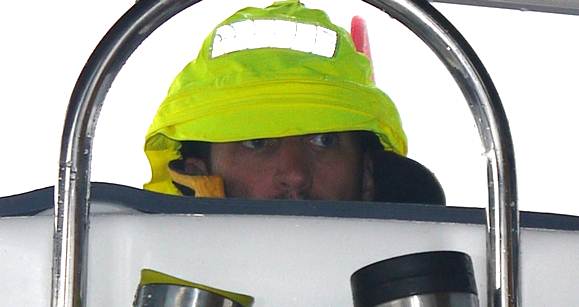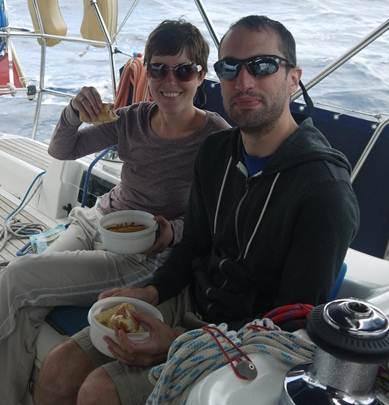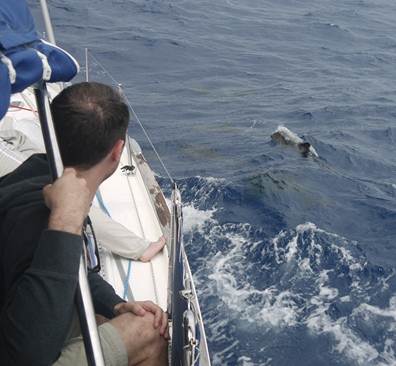Back in the Atlantic 11 - 14 May

31:16.173N 077:02.447W 48 hours into our passage from the Bahamas to the States. Our plan had been to follow the weather and routing advice to the letter by sailing directly north before crossing the Gulf Stream and making the passage round Cape Hatteras and into Chesapeake Bay. Unpleasant weather was forecast in the Chesapeake so the plan was to arrive ahead of it. If we could not get sufficiently north in time then we would go to Beaufort, North Carolina and carry on north along the Intra Coastal Waterway. We left Marsh Harbour as soon as the tide was high enough to let us out on Friday. It was wet and cold. Not what Ross and Lauren had hoped for but, suitably attired, Ross took the helm…….
Two other yachts, AnamCara and Cloud Nine, left at the same time. It is always good to be travelling in company even if you can’t see each other over the horizon. We spoke to them on the radio and we all had the same plan. The other two intended to travel more quickly than we are able to and carrying more sail very gradually got ahead. We had a last call at nightfall and agreed to speak the following morning to check all was well. We always slow the yacht down overnight and reduce sail in order not to have any dramas when it is dark and especially if it is very windy and there is a threat of squalls. Mike made contact early Saturday morning after a very stormy night, but AnamCara said they had a couple of issues and would call us back. Not too surprised by that because when there are only two of you on board you can easily both be involved in something and so not have a free hand for the radio. We also found we had caught up with Cloud Nine and discovered that they had torn their headsail during the night. AnamCara hailed us at mid-day but couldn’t hear our response. They tried Cloud Nine but couldn’t hear him either. They kept trying but couldn’t hear either of us. We tried them. No reply. We started to think they had a problem. We spoke to Cloud Nine and agreed we would keep trying. We then heard AnamCara put out a call for the US Coastguard and say they had two broken shrouds (the cables that hold the mast up) and their engine had overheated. There was no response from the USCG, not surprisingly because we were 150 miles off shore, way beyond their VHF radio range. We knew AnamCara didn’t have a long range radio or a satellite phone so they really were isolated. They put out another ‘all ships’ call and gave their position so we now had the key bit of information – where exactly they were. We turned towards them, as did Cloud Nine, and estimated it would take us two hours to get there. Mike used our satellite phone to contact the USCG and gave them all the information we had. After about an hour AnamCara could again hear us on the radio so we were able to tell them that the USCG knew what had happened and where they were. They said that they had tied their spare lines to the mast to try to stabilise it and were changing a shattered impeller in the engine. Difficult tasks given that we were all rolling on a big sea. The real threat was their yacht dismasting because there is a good chance the mast will torpedo a hole in the boat before they are able to cut the remaining wires free. And there was some bad weather on the way. We passed on a request for more information from the USCG and duly relayed the answer by Sat phone. We kept up regular radio “morale boosting” contact with AnamCara who were incredibly in control and calm. All the more impressive when you read the detail of the story on their blog; they were having a really difficult time. In turn, the USCG rang us several times for updates or with further questions. AnamCara got their engine going, turned left and headed slowly for the nearest bit of coast. On our next radio contact we relayed that the USCG had dispatched a cutter. We thought this was impressive and very reassuring. We later learnt that they had sent a plane as well. We were still 6 miles away from them when they were able to use their engine and get moving again. It would have taken far longer to catch them to offer assistance that by this time they didn’t really need, and we would then have been in completely the wrong place to proceed with our own weather dodging strategy. They were keen that we turned back onto our course but keep in touch as long as the VHF radio range would allow. The USCG gave us the all clear to break off and proceed north, but asked that we keep calling AnamCara for as long as we were within radio range, as they, like us were worried that if the mast did go in the swell that they would be in dire straits with no way of contacting USCG. We went out of range and lost contact around 1800 hours. Moral of the story. If you intend to go more than 20 miles offshore you need something other than a VHF radio to communicate with. We have both a sat phone and a long range radio which cost a lot of money but seems cheap at the price for the peace of mind and additional safety it brings. Other than that, our first day was very rolly and uncomfortable, especially for Ross and Loren who suffered the mal de mer in spite of all the anti sea-sickness remedies. They bounced back though and were both great company and great crew. Ross just got stuck in when we were helping AnamCara and filled in any gaps whether it was speaking to AnamCara on the radio or taking the helm to adjust our course. We have Barrett the wind vane steering for us again and both Ross and Loren quickly got the hang of tuning him. We lost quite a few hours while helping AnamCara which meant it was likely we would miss our weather window to get round the notorious Cape Hatteras. Straight to Beaufort then and make the rest of the trip along the waterway. Ross and Lauren both got their sealers sufficiently to tuck into hot dogs brought all the way from Gibraltar for a warm lunch some day when the weather was gloomy.
|


